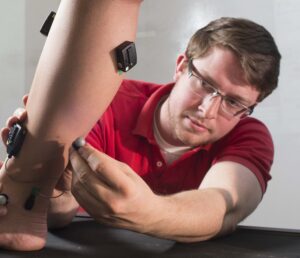Congrats to Matt Yandell, whose research on barefoot gait was published in Nature Scientific Reports
Matt’s research study entitled “Preferred barefoot step frequency is influenced by factors beyond minimizing metabolic rate” has been published in Nature Scientific Reports. This is Matt’s first first-author publication. Karl Zelik was a co-author and the PI for this study, which was carried out in the BAT lab at Vanderbilt.

Abstract
Humans tend to increase their step frequency in barefoot walking, as compared to shod walking at the same speed. Based on prior studies and the energy minimization hypothesis we predicted that people make this adjustment to minimize metabolic cost. We performed an experiment quantifying barefoot walking metabolic rate at different step frequencies, specifically comparing preferred barefoot to preferred shod step frequency. We found that subjects increased their preferred frequency when walking barefoot at 1.4 m/s (~123 vs. ~117 steps/min shod, P = 2e-5). However, average barefoot walking metabolic rates at the preferred barefoot and shod step frequencies were not significantly different (P = 0.40). Instead, we observed subject-specific trends: five subjects consistently reduced (-8% average), and three subjects consistently increased (+10% average) their metabolic rate at preferred barefoot vs. preferred shod frequency. Thus, it does not appear that people ubiquitously select a barefoot step frequency that minimizes metabolic rate. We concluded that preferred barefoot step frequency is influenced by factors beyond minimizing metabolic rate, such as shoe properties and/or perceived comfort. Our results highlight the subject-specific nature of locomotor adaptations and how averaging across subjects may obscure meaningful trends. Alternative experimental designs may be needed to better understand individual adaptations.
ARTICLE